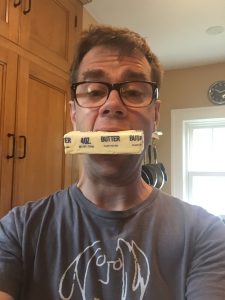
Breakfast
For breakfast a few days ago I ate French toast and bacon. I melted some butter and soaked the French toast in it then covered it all in maple syrup. Then I drank about 4 cups of coffee. Later that day I ate a handful of chocolate-covered raisins. And a bunch of tortilla chips straight from the bag with salsa. I snacked on crackers and cheese later. Somewhere in there I grilled a steak and drank a 16-oz IPA, followed by more chocolate-covered raisins. I did exercise a little, having dug up some shrubs in the yard, so there’s that.
I got on the scale. 10 pounds heavier than last year. All in my expanding belly.
This little parable of mine represents a sad lack of healthy living on my part. At least our dog, Zoe, joined me by finishing half the bag of tortilla chips and leaving the empty bag on the floor, thus preventing me from doing the job myself.
The next day I signed up for the Twin Cities Marathon in a moment of either insanity or brilliant goal-setting.
I guess I’m a Type A
All this got me to thinking . . . how do we motivate to do what we all know we should do? I’m going to cover healthy eating mostly today, but first, a bit about motivation.
Remember the “Type A” and “Type B” personality types?
I used to swear I was a Type B. Totally laid back and care-free. I fancied myself a “go-with-the-flow” king of guy, letting life hit me where it may and being cool with it. A real Woodstock-y born-in-the-sixties kind of guy. My friends used to scoff at this – pointing out that I tend to be somewhat more goal-driven and always looking out for the Next Great Thing, which somehow didn’t jive with my self-proclaimed Live In The Moment perception of myself.
I was a Type B. Totally laid back and care-free. I fancied myself a “go-with-the-flow” king of guy, letting life hit me where it may and being cool with it. A real Woodstock-y born-in-the-sixties kind of guy. My friends used to scoff at this – pointing out that I tend to be somewhat more goal-driven and always looking out for the Next Great Thing, which somehow didn’t jive with my self-proclaimed Live In The Moment perception of myself.
So I’ve resigned myself to my Type A-ness.
I like to set goals. Sometimes the goal is really long-term (signing up for medical school comes to mind). Sometimes it is medium-term (signing up for a marathon in five months) and sometimes it is more immediate-term (planning a healthier diet for this coming week).
I’m not expert in any of this (you’d be surprised how little education we get in medical school on diet, exercise and other healthy living topics). But I do get to talk to people every day in my practice about their own successes and setbacks in setting healthy lifestyle goals. Here’s a few reflections . . .and some links to helpful interactive sites.
Butter is yummy, so have at it. Just not so much.
So I was appalled when I found out how much fat and salt and calories are in the foods I ate that day. So the take home point is: don’t eat so much fat and salt and calories. But I think most of us underestimate what we actually eat that is bad for us and overestimate the healthy foods that we think we eat. I know I do. I don’t eat as much kale and quinoa as I think I do.
My goals for the coming days and weeks are around diet. Here’s something you should try: I used a really cool interactive site from the USDA where you type in a food and it gives you all the nutrition details. I really encourage you to give the USDA Food Tracker site a try – it has just about any food item imaginable and it is really informative (and humbling) when you see what you are actually eating.
Let’s take a look at my artery-clogging and weight-producing diet from a few days ago:
[table id=1 /]
Here’s the lowdown on my diet that day:
[table id=2 /]
Good grief.
In one day . . .
- I ate too much salt. Recommended salt for a guy my age = 2,300 mg daily. Most of us eat way too much salt, which can lead to worsening blood pressure, higher risk of stroke, and higher risk of heart disease. Trouble is, as much as 70% of the salt we eat is is added to the food before it gets to us. There is a recent FDA recommendation to address this very issue, hot of the presses yesterday. Read about it here.
- I ate way too much fat. At least on this day, something like 40 percent or more of my calories came from fat. And worse yet, much of my fat calories came from the bad kind – saturated fats – things like butter and bacon and Lord-knows-where else. You should limit fats to something around 25 percent of your calories and
 they should be the unsaturated fats – which come from things like fish, nuts, vegetable oils (olive oil, anyone)? For you chemistry nerds, saturated simply means the fat has no double bonds because of all the hydrogen molecules attached to it. You can often spot a saturated fat because it is a solid at room temperature. Like butter. Not like olive oil, which is a liquid at room temperature. Easy. Here is more about the fat guidelines from the good people at the American Heart Association. Note that this is a bit controversial. There are good arguments and some good scientific studies that show that fats are not the problem – even the saturated ones – but sugars and carbs are the problem. I think there is something to that. But nearly half my calories from lots of fats and processed foods – can’t be a good thing.
they should be the unsaturated fats – which come from things like fish, nuts, vegetable oils (olive oil, anyone)? For you chemistry nerds, saturated simply means the fat has no double bonds because of all the hydrogen molecules attached to it. You can often spot a saturated fat because it is a solid at room temperature. Like butter. Not like olive oil, which is a liquid at room temperature. Easy. Here is more about the fat guidelines from the good people at the American Heart Association. Note that this is a bit controversial. There are good arguments and some good scientific studies that show that fats are not the problem – even the saturated ones – but sugars and carbs are the problem. I think there is something to that. But nearly half my calories from lots of fats and processed foods – can’t be a good thing.
- My protein intake wasn’t too bad. The recommendations are rather broad on how much protein to eat, with the suggestion that you eat between 10-35% of calories from protein. So for my roughy 2000 calorie day, I ate about 18% in protein (almost all due to the steak, which is not a usual thing for me). If anything, I could have eaten more protein and less fat! Here is good info about proteins.
Another word on carbohydrates and sugars
I didn’t cover here what may actually be the worst problem of all in most of our diets – sugars and processed foods. I’ll talk about that later. I think it is really true that the worst culprits are the processed foods and simple sugars in our diets. In fact, if I had to advise people what they should most cut down on it would be simple sugars and processed foods. So eat the butter and bacon. Maybe just not in massive quantities!
Making these calculations
It’s easy to figure out how much each nutrient contributed to your caloric intake if you know these numbers:
- Proteins and carbohydrates: 1 g = 4 calories
- Fats: 1 g = 9 calories
In my defense, this was not a typical day (normally I eat many more vegetables and fruits and things). But I really did eat this stuff on that day and the results are eye-popping in the badness of it all. And I didn’t even mention the carbohydrates.
Keeping a food diary
I think knowledge is the first step toward a healthier life, and perhaps it will be motivating for you, like it was for me. One other way to find out about your own eating habits is to keep a food diary. You can download one here. Nothing fancy.
Knowledge is power! Find out what you are eating and let me know what works for you – leave me a comment below.
And now time to lace these puppies up and start moving!
